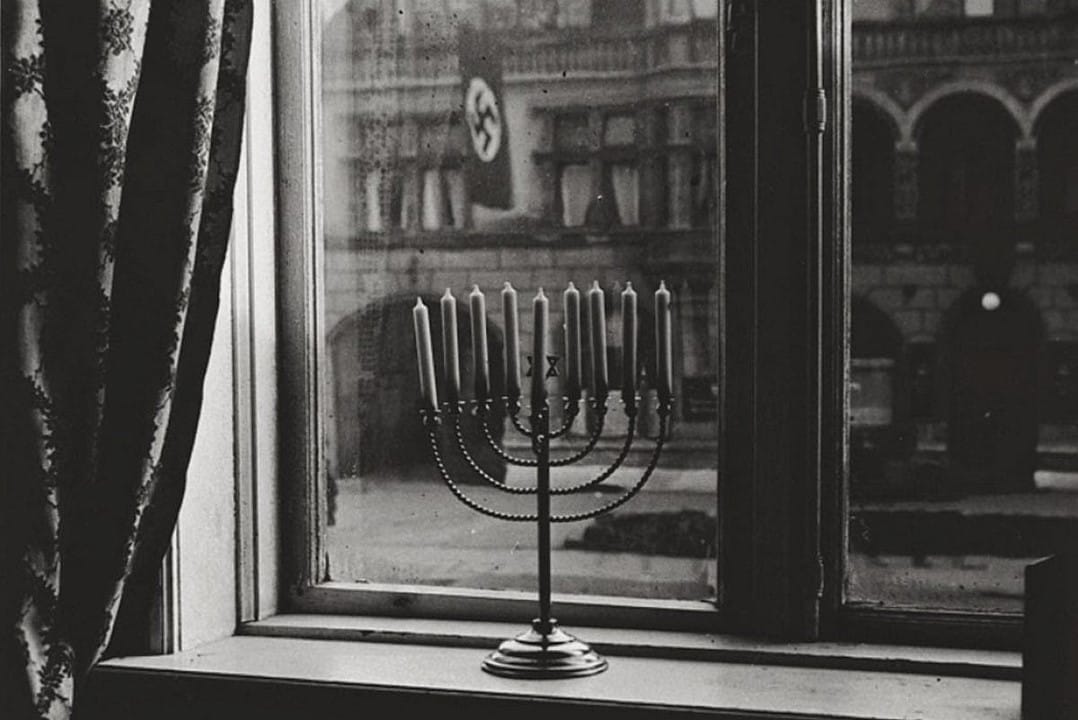This Hanukkah especially, take inspiration from my family’s act of defiance
As some Israeli soldiers light Hanukkah candles on the ruins of Palestinian homes in Gaza, we must look to the rich Jewish tradition of opposing tyranny.

This article was originally published in +972 Magazine.
It has been 66 days since the atrocities carried out by Hamas in southern Israel, and since Israel began its nightmarish assault on the Gaza Strip. October 7, the first day of the war, was also the Jewish holiday of Simchat Torah, which occurs on the last day of the holiday of Sukkot. Now, two months later, we find ourselves beginning the next Jewish holiday: Hanukkah. But this Hanukkah feels more complicated than any I can remember.
A week before the start of Hanukkah, Israeli soldiers brought a huge hanukkiah — a nine-branched candelabrum lit by Jews around the world during the eight-day festival — into Gaza. The soldier holding the camera proudly smiles and announces that it is “the first hanukkiah in Gaza,” while the other soldiers around him cheer, the rubble of Palestinian homes and buildings visible in the background.
A headline about the hanukkiah in the right-wing Israeli newspaper Israel Hayom proudly stated: “We will drive out the darkness with light.” But looking at soldiers assembling a hanukkiah on top of the ruins of Gaza, where the army has killed more than 18,000 Palestinians in the past two months, was a moment of deep darkness for me.

This image brought to mind a Hanukkah photo from a very different place and time: one in which a hanukkiah sits on a windowsill while, in the background, a swastika flag hangs from a building. The photo, taken in 1931 in Kiel, Germany, strikingly captures the eve of Nazism’s ascension. That hanukkiah was lit by Rabbi Dr. Akiva Posner and his wife, Rachel — my great-uncle and great-aunt.
The fact that this photo is part of my own family archive has always made me proud. Like any photo, it can be read in different ways. For me, it represents a legacy of defiance, the importance of celebrating one’s Jewishness as a subversive act, and the significance of holding on to ritual even in the face of grave danger. It symbolizes the power of resistance and moral courage, which are core to the kind of Jewishness I seek to embody.
The hanukkiah lit in Kiel against the backdrop of a swastika feels like the polar opposite of the hanukkiah standing on the ruins of Gaza. While the Kiel hanukkiah celebrates defiance in the face of oppression and the sanctity of ritual, the Gaza hanukkiah glorifies death and destruction.
This death and destruction is not an accident or an unintended consequence of Israel’s military operation in Gaza: Israeli officials have called for a permanent forcible transfer of Palestinians in Gaza, and, as our recent investigation demonstrated, the army is fully aware of civilian casualties when choosing its targets. Among the Israeli public, too, there is increasing legitimacy for calls to “flatten Gaza” and decreasing concern for the collective punishment being carried out against civilians.
In less than a century, we have moved from lighting candles against a backdrop of the genocide of Jews to a world in which there are Jews lighting candles to affirm, legitimize, and celebrate a genocide that they themselves are involved in committing.

Reflecting on the brave acts of Jewish resistance and defiance throughout history, including my own family lighting that hanukkiah against the backdrop of the swastika, ought to push us in the Jewish community to consider more seriously how we can use our faith, tradition, and culture to bring about a more just world. Jewish history is rich with examples of how we have opposed fascism and resisted racism throughout history. Turning to those examples at this difficult time can help us in fighting the widespread hatred, fear, and vengeance that are currently so prevalent in Israeli society.
Looking to our history for inspiration does not mean romanticizing those moments in which Jews were under horrific attacks and dealt with grave danger, bolstering an image of the Jew as constantly suffering and a pariah by disposition and destiny. But the violence and racism inflicted upon us as Jews should be a constant reminder to cherish humanity above all and resist racism enacted in our name.
As I prepare to light my own hanukkiah, it feels unbelievable that the war is still raging, that the Israeli army is continuing its unchecked attacks on Gaza, and that Israeli hostages are still being held captive. This Hanukkah, may the Kiel hanukkiah serve as a call to celebrate and treasure life.
Inspired by the defiance embodied in my family’s hannukiah, we must call to prioritize bringing home all of the hostages, to stop the immense death and suffering being inflicted on Palestinians, and to achieve a political resolution that ensures all human lives between the river and the sea are protected. We must demand that genocides are a thing of the past and work to bring light into our midst through resistance to racism and fascism — including when it comes from those who claim to speak in our name.
There is always another way to read history and to brush against its grain in support of the crucial value of humanism. In this horrific moment in Israel-Palestine, my great-aunt and great-uncle’s hanukkiah teaches us to not be afraid to dissent, and to fight to drive out the darkness and bring in the light. ▼
Dana Mills is a writer, activist and dancer, and the resource development manager at +972 Magazine/Local Call.
Author

Dana Mills is a writer, activist and dancer, and the resource development manager at +972 Magazine/Local Call.
Sign up for The Pickle and New, From Vashti.
Stay up to date with Vashti.



